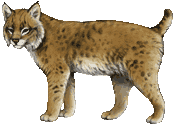|

Description: Spotted body and legs; more reddish in color than the lynx; ear tufts and sideburns short; black
on tail only on top half; feet smaller than the lynx. Male, 25 to 30 inches long; 5-inch tail; 20 to 35 pounds.
Female, slightly smaller, 15 to 25 pounds.
Similar species: Lynx-larger; tail circled at tip with black.
Habitat/Distribution: Dry rock mountainsides, shrub land, coniferous forests, broken rocky country throughout the
region and in RMNP.
Food: Mostly rabbits and hares, also ground squirrels, mice, birds, insects, lizards, crayfish, and frogs.
The most common cat in the region, the bobcat is shy and furtive, moving about in thick vegetation or under the
cover of darkness. It flourishes in the broken, semi-wild areas left by logging, burning, and other human activities.
Efficient predators, they locate prey in poor light with eyes that are almost six times as acute as our own or
with ears that are especially sensitive to high-frequency sound, such as the squeak of a mouse. Once located, the
prey is stalked or taken from ambush. Powerful legs give the bobcat blinding speed over short distances. If the
prey is not overtaken with a short dash, the cat breaks off pursuit and searches for another animal. Once overtaken,
the prey is caught and held by razor-sharp retractable front claws and then dispatched with a bone crushing bite
behind the neck.
The social system of bobcats is similar to that of the cougar, with overlapping home ranges and breeding between
males and females whose home ranges overlap. Possession of a home range is maintained by a system of scent and
visual signals. The resident bobcat squirts urine along travel routes and makes scrapes at trail inter-sections
and at other important locations in the home range to advertise his presence. An intruding cat that comes upon
these marks usually respects the territorial rights of the resident and moves on.
Kittens are raised in caves or some similar location. At about 1 7 days, they begin to play with each other. The
playing gets progressively rougher and soon includes mock fighting. These rough-and-tumble games sharpen reflexes
and develop strength to prepare the kittens for life on their own.
|